Muir's "Range of Light"
![A View from Muir Pass]() A view from Muir Pass
A view from Muir Pass![View from Muir Pass]() Another view from Muir Pass
Another view from Muir Pass
The sight of the Sierra Nevada rising from the Owens Valley in eastern California is unforgettable and ranks among America’s greatest spectacles. Famous peaks such as Mount Whitney, Mount Williamson, and the Palisades soar more than 10,000 feet above the towns of Bishop, Big Pine, Independence, and Lone Pine, and the drive along U.S. 395 between Lee Vining and Lone Pine is one of the most inspiring in America. One has to wonder how many accidents have resulted from drivers’ staring out their windows instead of paying attention to the road, but it’s like driving through Jackson Hole—no matter how many times you’ve seen the Tetons or been on or among them, how can you not look, anyway?
The great gesture of rock that is the eastern face of the Sierra Nevada is also an important reminder that there is far more to “The Range of Light” (John Muir) than just Yosemite Valley. “The Incomparable Valley” is many people’s first impression of the Sierra Nevada, and for some it is the only, but many others have gone higher and deeper into the wonders of the High Sierra to behold the wonders that have inspired countless artists, photographers, writers, hikers, and, of course, climbers.
I got my first chance in July 1999, three years after my first visit to Yosemite. Some spring and winter visits to the Owens Valley in 1997 made those high peaks tantalizing to me, and so I resolved to explore the high country in summer when conditions would be more suitable for my preferences and my experience. It was not to be my first time hiking in the alpine world—summer trips to the Rockies in 1997 and 1998 gave me my starts to that—but it would be the first time going backpacking into the great mountains of the West and seeing the kind of deep, wild, and pristine mountain country that only a relative handful of people in the world ever see.
My brother Chris and I made three multi-night trips into the mountains—the first to the Monarch Lakes in Sequoia National Park, the second over Bishop Pass and to Muir Pass in Kings Canyon National Park, and the third over Kearsarge Pass to the Rae Lakes (also in Kings Canyon)—and some day trips, including a hike to the summit of Mount Whitney and back. The Kearsarge trip wound up proving to be perhaps the most influential in my hiking/climbing life, and I’ve written about that in an
article, but the Bishop Pass-Muir Pass was the best for scenery, weather, and what it opened up. Nearly eight years later, I still think some of the places I saw out there are among the top few of the most amazing places I have ever seen.
This trip report is about hiking, not climbing, and it is about inspiration and revelation. But the trip was a prelude to climbing, for it awoke an urge to get closer to and higher up the mountains, and it remains a defining experience for me.
Day 1—Monday, July 5: Exhaustion and Awe
![Long Lake]() Long Lake, John Muir Wilderness
Long Lake, John Muir Wilderness
Beginning from the parking area at South Lake, almost every step of the Bishop Pass trip took us through stunning country. The trail began high, so it didn’t take long to get away from the trees. The same wasn’t true for the mosquitoes, which were intolerable most of the time when we weren’t both above treeline and away from water. They were especially bad around Dusy Basin—through which we almost ran on our way into LeConte Canyon. There was almost no breeze at all, which is often a nice thing high in the mountains, but this time all it did was let those mosquitoes keep after us, and repellent actually seemed to be more like an attractant.
But the scenery compensated quite well as we passed several lakes and peaks on the 6.5-mile climb to Bishop Pass, where the heart of the High Sierra opened before us. On the way up, though, I endured some mild altitude sickness that had me feeling weak, nauseous, and dizzy and required me to stop and rest a few times. I’ve only experienced any altitude sickness a few times, though, and that time has been the worst thus far. Although the altitude sickness made me feel a bit ashamed, I had to remind myself that it sometimes occurs to even the best-conditioned climbers, and I’m not just talking about in places like the Himalaya. So I had a good rest at the pass, the symptoms disappeared, and we continued to base camp, another 6.5 miles away—it was all downhill, but we were already very tired, unused as we were to long, steep climbs with heavy packs and at high altitudes, and thus it was an exhausting day. Again, though, scenery compensated as we passed a large waterfall and the crags of LeConte Canyon beckoned us to a soft, pine needle-strewn campsite in its shadowy depths.
![The Citadel]() Campsite view-- The Citadel
Campsite view-- The CitadelDay 2—Tuesday, July 6: The Prettiest Place in the World?
![Lake Helen]() Lake Helen
Lake Helen
Shortly after sunrise, we hiked the 7 miles to Muir Pass, and that stretch of the John Muir trail was unforgettable, especially the exposed, gleaming granite of the walls of LeConte Canyon; the high, barren traverse from Lake Helen to the pass, a place of calendar-quality scenery; and the views into the upper reaches of Evolution Basin. Deep-blue tarns, waterfalls, wildflowers, and raw rock abounded. Each step was so thrilling that I spent the whole time just reveling in the fact of being alive. The pass was one of those places I did not want to leave, and although the question above is not intended for serious debate, it is hard to argue that the scene from Muir Pass would not belong in that debate. Another interesting thing about the pass is Muir Hut, a stone hut that would make a neat, if not entirely comfortable, place to spend a night.
![Wanda Lake]() Wanda Lake from Muir Pass
Wanda Lake from Muir PassDay 3—Wednesday, July 7: A Bear, More Mosquitoes, and One Fine Lake Basin
Dusy Basin was next, and this time for more than racing through. We spent our third night there and explored the rockbound lakes in it both in the evening and the following morning. The weather was, as it was for all of this excursion, fantastic—warm and sunny with just the right amount of afternoon clouds to make beautiful pictures.
![Dusy Basin, Late Afternoon]() Isosceles and Columbine, late afternoon and evening...
Isosceles and Columbine, late afternoon and evening...Not Smokey the Bear
But first we had to deal with a bear. Anyone who thinks only grizzlies are dangerous and that black bears are basically harmless should read this. Close to our campsite in LeConte Canyon, there is a ranger cabin. A hiker passing by told us how a black bear had broken into the cabin and made one fine mess. He also mentioned that the bear was currently eating breakfast and didn’t seem disposed to having company.
We knew better, but we had to go see. It wasn’t for pictures—I’d seen and photographed bears before. There’s just something really cool about seeing a bear in the wild. So we approached cautiously after reviewing with each other how to act in the presence of a bear. We found the cabin before the bear, and, if anything, that other hiker had understated the scene. The torn door and the scattered debris made the setting reminiscent of an illegal dumping site in a rural area, but that ruined door was also a stark statement about the power of what made the mess in the first place.
Then we saw the bear, which was far enough away not to scare the hell out of us but close enough for us to see how large it was—I have seen smaller adult grizzlies. And then it saw us. It looked up from the can or jar it was busy tearing apart, considered us for a moment, got up on its feet, grunted, and charged.
Once, in high school, I was riding shotgun when the driver lost control and veered into a ditch on the right side of the road. As we approached the culvert we were going to crash into, a process that took only a few seconds in real time but which seemed horrifyingly slow to me, I braced myself for the impact but felt certain I was going to die (I am convinced wearing a seatbelt saved me). Until the day that bear charged, the anticipation of that fatal crash was the most frightening thing I had ever endured.
The bear’s charge made me cold with fear and a sense of smallness, of complete helplessness. The instinct to run seized me, but my reason held on. Fortunately, it was just a bluff charge—the bear stopped maybe just two seconds after it started, but those seconds were as terrifyingly slow as the ones just before the car crashed that rainy night in 1987. We backed off slowly but steadily, not making eye contact, and I readied myself to drop and curl up, knowing that the loaded backpack I had on might be my best and only protection in case of a real attack.
The fright over, a few nervous laughs and epithets later we headed back up the trail to Dusy Basin and Muir Pass.
![Dusy Basin]() Palisades country
Palisades countryTorture That Would Work
Torture—there have been some big debates about its effectiveness and its acceptability lately. I have heard stories of mosquitoes in Alaska driving moose to madness, making the moose plunge from cliffs as popular lore says lemmings do (they don’t), seeking relief in death. Whether that’s true or not I couldn’t say, but I can certainly imagine it happening. And so I humbly submit that tying a man naked to a pole and letting mosquitoes have their way with him would make almost anyone talk. Up at Dusy Basin, where we made camp for the night, my brother and I spent a hot, sweaty, miserable afternoon in a small, stuffy tent because the mosquitoes were just unbearable outside. Strangely, the bloodsucking crowds abated in the late afternoon, and we had about two glorious hours to explore Dusy Basin before sunset.
![Sunset from Dusy Basin]() Sunset
SunsetDay 4—Thursday, July 8
At dawn, I rambled about the lakes again and got one reflection shot I’ve always thought of as one of my best. Reluctantly, we left Dusy Basin a couple of hours later and hiked back over Bishop Pass and to the car. The lunch buffet at the Sizzler in Bishop made for what at the time seemed to be one of the best damn meals I’d ever had.
Words just can’t describe Dusy Basin with justice. It is unquestionably among the most beautiful alpine locations I have ever attained, on-trail or off. Beautiful Sierra Nevada peaks soar all around the several rockbound lakes there, and it is one of those places that is so overwhelmingly beautiful that you may just have to sit down so that you don’t drive yourself to exhaustion running from place to place and dashing for every nearby mountain.
If Only...
If only we’d planned for staying out at least two more nights so we could have seen Evolution Basin.
If only the climbing bug had hit me when we were at Muir Pass or in Dusy Basin—still, I did my first off-trail hike/scramble a few days later in Kearsarge Basin, and I haven’t looked back since.
If only those days could have lasted forever—warm, cotton candy-cloud days with perfectly clear mornings and nights. Back then, I thought Heaven for me might be an endless John Muir Trail with no backpack and no need to ever stop. I’d still settle for that.





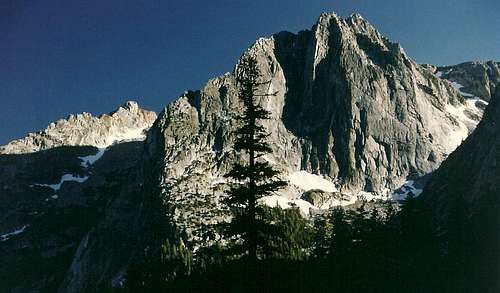

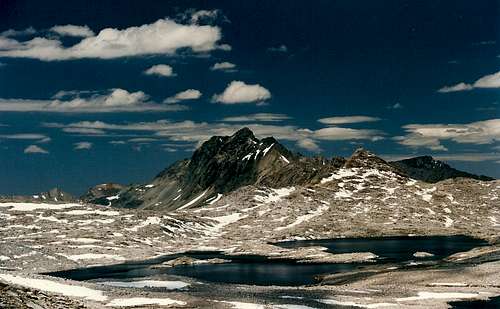
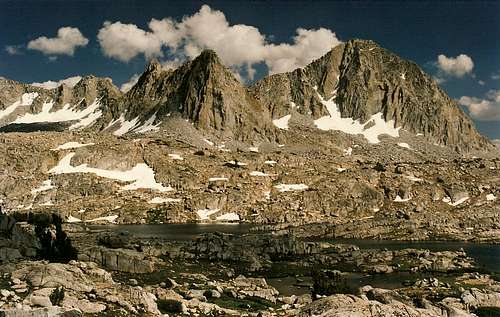

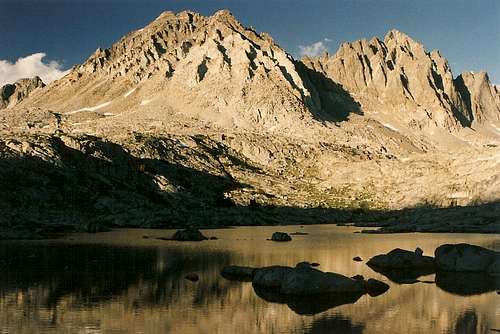
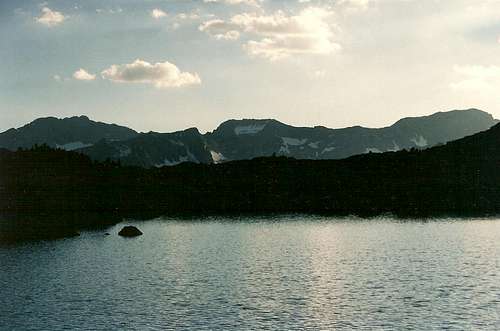



Comments
Post a Comment